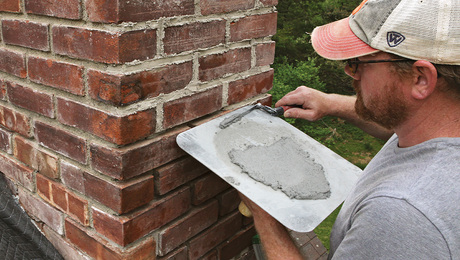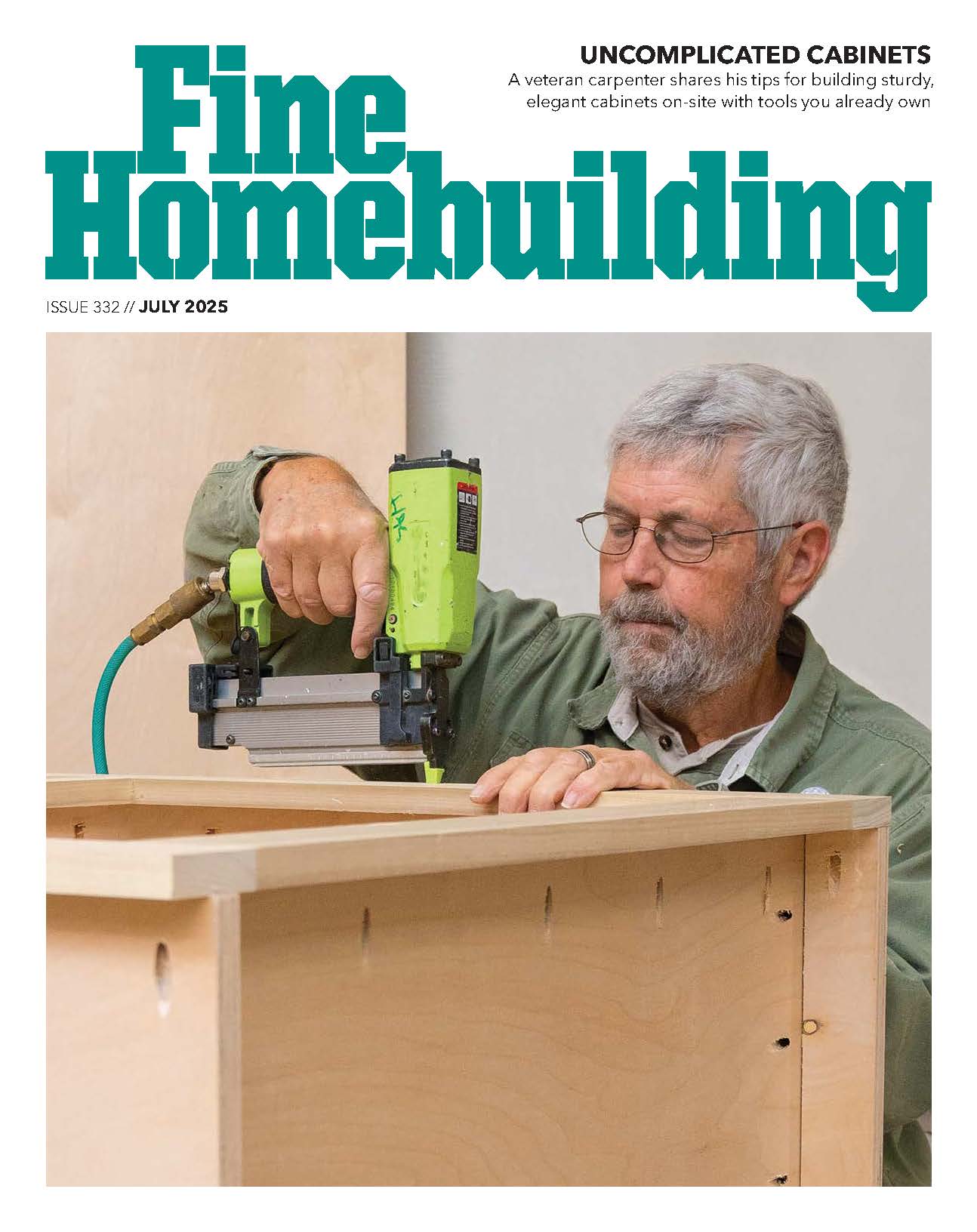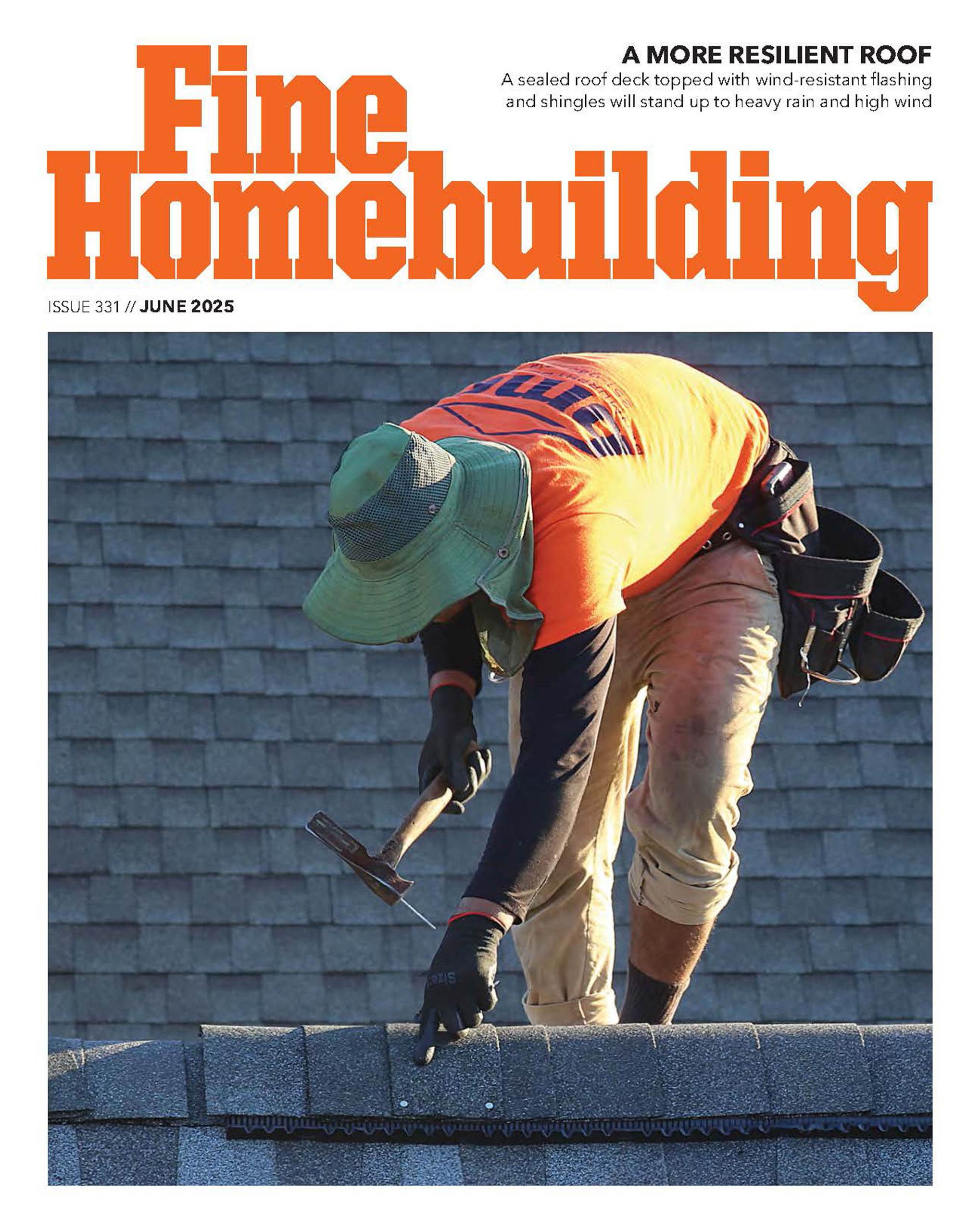Hi All
I am forming and partially digging footers for a house. The side of the house that is formed is on a rock slab. One corner has a iregularity in the rock that appears be a boulder sitting on top of the slab. It is too wide to dig around and remove, to large for a backhoe to move and the shape is going to cause my footing to make quite a step up to go over it. I am sure I can form over it, pin it , then backfill but I am unsure about 2 aspects of this:
1) Should I be concerned about the boulder moving/settling in the future?
2) Can I use a cutoff saw to just channel through it and save some time forming and backfiling?
I have no experience with this type of problem. Has anyone here tried cutting their way through granite to form a footer?
HC
Discussion Forum
Discussion Forum
Up Next
Video Shorts
Featured Story

Old masonry may look tough, but the wrong mortar can destroy it—here's how to choose the right mix for lasting repairs.
Highlights
"I have learned so much thanks to the searchable articles on the FHB website. I can confidently say that I expect to be a life-long subscriber." - M.K.
Fine Homebuilding Magazine
- Home Group
- Antique Trader
- Arts & Crafts Homes
- Bank Note Reporter
- Cabin Life
- Cuisine at Home
- Fine Gardening
- Fine Woodworking
- Green Building Advisor
- Garden Gate
- Horticulture
- Keep Craft Alive
- Log Home Living
- Military Trader/Vehicles
- Numismatic News
- Numismaster
- Old Cars Weekly
- Old House Journal
- Period Homes
- Popular Woodworking
- Script
- ShopNotes
- Sports Collectors Digest
- Threads
- Timber Home Living
- Traditional Building
- Woodsmith
- World Coin News
- Writer's Digest


















Replies
Tim Mooney may have some dynamite left over from his well adventure LOL...have a blast!
Don't worry, we can fix that later!
Any chance you have an engineer for the job? I'd sure be interested in knowing what they'd recommend. Around here we get a rock hammer on an excavator and get that sort of thing out of the way.... and it sure does lighten the wallet.
Has anyone here tried cutting their way through granite to form a footer?
I had to cut a 3' x 4' slot through the old granite harbor wall at Dover docks and we used plug and feathers in holes drilled with a pneumatic rock-drill.
It took ages but it's probably the best way short of explosives -- which you might need a licenced contractor for anyway.
IanDG
>> Should I be concerned about the boulder moving/settling in the future?
Only if you remove enough dirt on the downhill side to give it some place to go. Otherwise, as big as you describe it, it's done settled.
>> Can I use a cutoff saw to just channel through it and save some time forming and backfilling?
How big a channel do you need to cut? And what's your time worth? If it's really granite, it's going to take a long, long time with any hand held saw, IMO.
I more or less think the same on this, but there really is not much info to go on in the thread.
how big is it?
Too big to dig
What kind of soils?
pretty dirty stuff
can I cut thru it?
How determined are you
is it a structural wal that transitions and loads to it?
dunno.
Welcome to the Taunton University of Knowledge FHB Campus at Breaktime. where ... Excellence is its own reward!
I hope this makes it back to my original thread. I am still learning how to use this board.
thanks for the help so far. To clarify a few details. The boulder is big but not tall. From what I have excavated it looks like a large plate. I want to cut two 18 inch sections anywhere from 6 to 10 inches deep. I am willing to spend the better part of a day cutting or pounding on it if it will help but I would rather form over it than spend big bucks on an excavator. Because it is a flat boulder I think I may be able to lift a section out if I can cut deep enough with a cutoff saw. What is plug and feathers?
HC
Can a guy get in the hole with a large saw?
With the proper saw and blade, the stone could be sliced in the direction of your footer. With four or five slices the depth your targeting, one can then chisel into the slice and break off a wedge. Keep breaking them off until you're wide enough and deep enough.
There are guys out there that hire themselves out to do this work. Some are rather cheep compared to what time, effort and rental cost you'd do otherwise.
What is plug and feathers?
A time-honored way of splitting rock.
First, you drill a hole in the rock, it needs to be around 24-30" deep, and about 3/4" diameter. Then you drill some more holes, along the line of where a body want the rock to split.
Into the holes go "feathers." These are semi-circular pieces of steel that vaguely resemble a handle-less gouge chisel. The top part of the feather is bent back over itsself not quite 90º or so.
The plug is a tapered hard steel rod. It is set between the feathers (the parts have complementary radii to help all the bits in place.
So, there's the stone. It's drilled, and all the feathers & plugs are in place. You now stand a fairly stout fella on the non-moving side of the split with a decently large bit of hammer. You then have Bubba give a good rap on each of the plugs one after the other. Down to one end, then then back again. After a bit, the "ring" of the steel=to-steel-to-stone will change. This is something to listen for. There's usually a crack visible connecting all of the "dots" of the drill holes. A tap or two more and the slab should part.
Now, this will only work if there's someplace for the slab to "go."
The Egyptians used this technique to cut slabs out of vertical rock faces. They'd chisel the bottom to define the edge & depth, then feather and plug the top edge. There's some argument about whether they built cribbign to "catch" the stone so that it remained more nearly vertical, or if the slab was just allowed to tip over--the cut dimension being thich enough to mostly prevent breakage.
Whether that will work for you--that, I don't know.
I might be a little leary of using a "boulder" on (presumed) ledge as part of my structural system. I'd likely be more so in areas needing seismic compliance; or with deep freeze lines; or with large rain/snowfalls. As previously posted-- "we" don't have enough info.
We know you've posted 7 times since joining on 13 July (Welcome to BT, belatedly). We don't know where the site is, or the project type and/or use is, etc. Mountain retreat cabin for hermits different than primary residence different than condos/hotel on the same location.
Hope that's some help (and not more confusion).Occupational hazard of my occupation not being around (sorry Bubba)
Is there gonna be a stem wall on top of the footer?
Basement?
What are the footer dimensions.
Are ya pinning the footer to the rest of the rock slab?
Take the time to type out a full description of what you have and what you are planning to build. The more we know, the more we can mess up. . .uh. . . I mean, the more we can help.
SamT
We had the same problem when we did my fathers place. We ended up building the footing over the roch and then designed the room around it.
Scott C. Frankland
Scott's WOODWORKING Website
"He who has the most tools may not win the race of life but he will sure make his wife look like a good catch when she goes to move on."
It it's that big why not just pin it and pour to it...
Life is not a journey to the grave with the intention of arriving safely in a pretty and well preserved body, but rather to skid in broadside, thoroughly used up, totally worn out, and loudly proclaiming
WOW!!! What a Ride!
I agree.
Probaly gonna need an engineer's sign-off, but in upstate NY the granite is WAY, WAY harder than concrete. Jack hammers, hole saws, none of that stuff hardly dents it.
If it is too big to dig out, pin it and use it as the footing (but get an engineer's sign-off). The engineer will cost a few grand, but probably cheaper than trying to get the stone out of your way!
Norm
In most cases not here for the engineer... Drill, pin and poxy...
If one is needed it's 300$ or so... Granite rocks here are the size of McMansions for the small ones...
Life is not a journey to the grave with the intention of arriving safely in a pretty and well preserved body, but rather to skid in broadside, thoroughly used up, totally worn out, and loudly proclaiming
WOW!!! What a Ride!
I don't think I'd cut it away. Why cut something away and replace it with something (concrete) less strong. I'd pin the new concrete work to the granite. I don't think I'd dig it out either. Why take out something with a huge foot-print and replace it with a 16" wide footing. Take advantage of what you have. I would have a concern if you put a building partially on a massive boulder with the rest of the house on some soil that has a potential for settlement. This could cause some differential settlement in the house an cause some cracking. If you're on good stable soils, leave the monolith alone and build right over the top of it. I did that exact thing with my shop. My footing bumped into the tail edge of a 10' boulder. I wasn't about to re-locate the shop and I sure wasn't gonna move the rock so I just poured over the top of it. There are no signs of problems to date. It would be a good idea for you to buy your local engineer a 6-pack and have him stop by for some added insight though.
I'm still curtious about all the advice given heere one way or the other on this one, with no knowledge of conditions. maybe I missed something, but I still don't know the size of this pebble or how deep it is relative to surface or to footing. I heard that it is "BIG" but one man's BIG is another man's toy for an hour. is it barely larger than a basketball, or more like the size of a VW Bug? Doesn't that make any difference to anyone?
Welcome to the Taunton University of Knowledge FHB Campus at Breaktime. where ... Excellence is its own reward!
Where I am (Adirondack mountains of upstate NY) we can pin a foundation to "ledge" but not to "rock."
Ledge is defined as an outcropping of bedrock. A rock is just that. Not attached. No matter how big, it comes out. Excavators drill and shoot them to break them into chunks that can be handled.
I see your beef, Piffin.
These young guns are all excited about a big rock, ready to bring in the heavy artillery. Well actually we don't even know if it's a rock or a ledger. Only the zen master Piffin can see his way through. :)
It's so nice that you're being curtious, just don't start curtsying around us LOL.
Here, unless you've got an excavator working his first job, the guy digging will know exactly what to, or who to call to find out what to do. I've done steps over real big rocks, no pinning, no ill effects, and they passed the inspectors.
And, an engineer's approval shouldn't cost more than a few hundred...all this advice doesn't mean a hill of beans if your inspector doesn't pass your footing trenches, so he's the one who can really give you the answers. Don't worry, we can fix that later!
Got nitro?